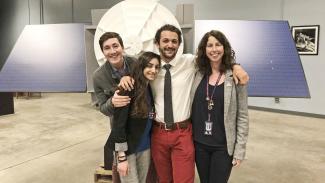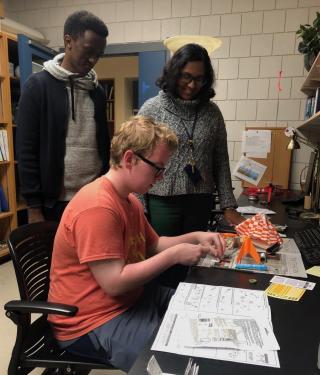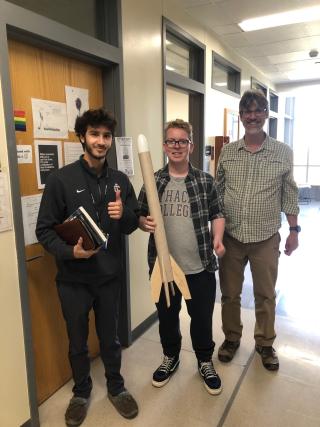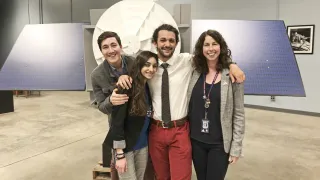Ithaca College faculty and students are studying the chemistry and evolution of proto-stellar and proto-planetary objects. We are a member of a team using the NASA Spitzer Space Telescope to gather infrared spectra of dust and gas orbiting stars other than the sun. Professor Luke Keller and his students reduce spectra from Spitzer Space Telescope, Stratospheric Observatory for Infrared Astronomy, Hubble Space Telescope, and other data archives and analyze the results, looking for atomic and molecular signatures of material orbiting sound stars that may be forming planets. They also use ground-based observatories to gather spectra and images of these objects. Their current focus is on Herbig AeBe stars, a class of stars that are several times more massive than the sun and show evidence of disks of gas and dust orbiting them.

From left, Robert Melikyan '20, Stavrini Tsangari '19, Salvatore Ferrone ’18 and Beth Ellen Clark Joseph, professor in the Department of Physics and Astronomy, have worked at NASA.

Current Projects

Observations and 3-D computer modeling of the early stages of planet formation
Luke Keller
Observations and 3-D computer modeling of the early stages of planet formation: We are investigating whether the process of planet formation is different when the abundances of heavier elements (Carbon, Oxygen, Silicon, etc.) in the material orbiting newly-formed stars are lower so that there is less dust. We analyze infrared and optical (visible light) spectra, ultraviolet and optical images, and photometric measurements of stars in the nearby Small Magellanic Cloud, a galaxy in which the chemical environment is heavy element poor.
Sonification of astrophysical spectra
Luke Keller
We are developing tools in Python that translate electromagnetic spectra into sounds; a process known as sonification. Sonification of data enables us to hear our astrophysical data. We are developing tools to enable audiences less familiar with light spectra and spectral analysis can appreciate the richness of these complex data; to enable blind and visually impaired scientists to experience the data sets, which are commonly presented as images and graphs; and we are investigating the possibility that using our sense of hearing, rather than our sense of sight, may in fact enable more thorough analysis of subtle features in the data.
NASA OSIRIS-REx Asteroid Color Photometry
Beth Ellen Clark Joseph
Using photometric models that describe the way light scatters off the surface of an airless body, we will study the color changes of the optical surface of asteroid 101955 Bennu, target of the OSIRIS-REx mission, that occurred due to the disturbance of the surface when the spacecraft touched down and sampled the rocks. We will seek to understand what causes color variations on one asteroid in order to investigate the compositional implications of the colors we observe for all asteroids in the solar system. For more information about the OSIRIS-REx mission and asteroid science, visit asteroidmission.org.
NASA OSIRIS-REx Asteroid Water Band Shape Shifting
Beth Ellen Clark Joseph
Using laboratory spectral data of water-bearing minerals such as those found on asteroid 101955 Bennu, target of the OSIRIS-REx mission, study the occurrence and causes of shape changes of the deep water band at 2.7 microns. The water band seems to be composed of overlapping gaussian-shaped reflected light absorptions, where each gaussian is attributed to different forms of water and hydroxyl molecules. The project before us will be to use laboratory simulations to investigate what causes 2.7-micron band shape shifts.

